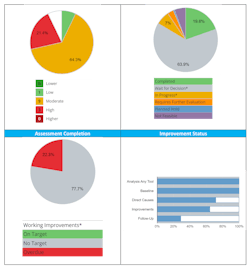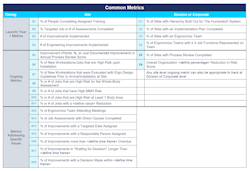Metrics are a vital part of a successful ergonomics process. Typically, the need to implement an ergonomics process comes from the desire to reduce injuries and costs, which are lagging metrics. Whether an ergonomics process is in early stages of implementation or further along, when identifying metrics for your organization, consider two questions:
- What do we want to achieve?
- How are we going to do it?
The answer to these questions can differ from company to company and from year to year, so staying loyal to one or two metrics is not going to ensure success. In fact, the key to success is understanding how different metrics combined will benefit your organization.
Leaning on a variety of metrics at different times or levels of maturity will keep your organization on the path toward success. Similar to the components of a song (melody, rhythm, bass and harmony), a single metric on its own is not as effective to an organization (a.k.a. the audience) as the combination of metrics working together.
Let’s dive deeper into the topic of metrics to help you understand what will work best for you. There are three categories of metrics to consider when implementing an ergonomics process:
- Leading metrics (melody),
- Activity metrics (rhythm) and
- Lagging metrics (bass).
Leading Metrics
Leading metrics predict the likelihood that an event might occur. Among the three types of metrics, they are the most effective, as we’re trying to predict what kinds of events might occur and how we can prevent musculoskeletal disorders (MSDs). Leading metrics should all be tied to risk and the reduction of risk. Systematically managing risk with a few leading metrics will satisfy leadership and keep the team results oriented. Examples include:
- percentage of workstations/jobs at low risk,
- percentage reduction of MSD risk score and
- percentage of new workstations at low/no risk upon installation.
Leading metrics are the melody of your ergonomics process. Just as having more notes doesn’t make the melody any better (only sound different), having too many leading metrics may make the process too chaotic. Therefore, select the appropriate one or two leading metrics to be the main metrics that guide your process.
Activity Metrics
You could have the best melody in the world, but if you don’t have a strong rhythm, or the appropriate cadence, you can quickly move off track. Activity metrics are the rhythm of the song, or the drumbeat; they reflect actions taken or tasks completed. They don’t measure how well something is performed or the impact on risk but rather specific activities the team is taking monthly, quarterly and annually to make sure they stay on track and consistent with their goals. Examples include:
- percentage of employees who have received training,
- number of jobs/processes assessed,
- number of workstations improvements identified,
- number of workstation improvements implemented and
- percentage of assessed jobs with a follow-up assessment completed.
Unlike the melody, more activity in the rhythm section can elevate a song to the next level. The outcomes of risk assessment and improvement activities provide measures of risk level and risk reduction.
Select targets that will be easy for the team to complete—and will drive them through the job improvement process. For example, task the team with completing two assessments per month and also two improvements implemented on previously assessed jobs. This will ensure that improvements are being made and that the focus isn’t solely on assessing jobs.
Consider which metrics will drive the desired behavior. For example, consider the image in Figure 1. A lot of assessments have been completed and improvements are being identified. However, too few improvements are completed, nothing is prioritized appropriately, no decisions are being made to move improvements forward with improvements and we are not completing the job improvement process. Adjusting the activity metrics will be effective because the team will focus less on the number of assessments and more on the number of improvements completed.
Lagging Metrics
Lagging metrics are typically initial program measures. They are the reason why an organization may implement an ergonomics process in the first place. Frequent injuries and high costs are what set the majority of ergonomics processes in motion. There is no fault in lagging metrics being a driver for the process. However, reducing injuries and costs is more of an end goal to an effective process and less of a metric to monitor success throughout the process.
One of the main reasons lagging metrics are not a good measure of success is that the results require specific activities and actions, and this can take time to yield results. More steps are required along the way to know if you are on the right track. If, at the end of a year of your ergonomics process, you have not achieved the reduction in injuries or costs that you were aiming for, it does not mean you need to change your process. Rather, it means you just aren’t seeing the results yet.
Injury and illness rate, days since the last injury, lost workdays and injury costs are all consequence data happening after the fact. They are still important measures to track, but they don't help us understand if we are moving in the right direction to achieve risk reduction goals.
Lagging metrics are like the bass of a song, which moves in contrast to the rhythm and melody. The bass is important—even vital—to a song’s success, but it is not as effective on its own.
Communicating Progress
Lean on all of the aforementioned measures based on where you are in your process, the culture of your organization and assessment of what is working or not working. For example, consider easy activity metrics when initially implementing the process. As you move into sustaining the process, challenge your organization to move toward more leading key performance indicators (KPIs) that require the team to focus on risk reduction and implementing actions to improve the workplace (see Figure 2).
Remember that metrics are not set in stone. Feel free to adjust to what isn't working for your executive team, ergonomics team and rest of the workforce. Switching metrics midyear is not a sign of failure; in fact, it helps highlight that you are engaged and flexible. Give metrics time to determine if they’ll work for your teams, but don’t be afraid to adjust. Often, making adjustments reinvigorates the process and will ultimately make it more successful. The worst thing to do when going down the wrong path is to not turn around.
Just as important as identifying the metrics is the way progress is communicated: How often? To whom? And how? Communication is the harmony of the song, an assist to make everything sound better. Good communication will bring everything together, improve popularity and ensure longevity.
Depending on the audience, you’ll want to present information in different ways. Limit visual tracking to the key measures you want to highlight. For activity metrics specific to an ergonomics team, consider a simple color-coded scorecard (see Figure 3). They’ll refer to this often to quickly understand if they’re on track.What about your leadership team? They won’t want to get into the weeds of how a song is made—they’ll just know a good song when they hear it. It’s therefore important to present your leadership team with evidence of progress toward broader goals (see Figure 4).
Look for ways to present information based on the types of questions they’ll be looking to answer: How much is this going to cost? When do we expect to see ROI? How successful have we been to date? Do you need anything from me?
To be most efficient and impactful, metrics should be accurate, understandable, meaningful, scalable, actionable and in real time. Although leading measures provide an early warning system and are the most effective way to track the success of an ergonomics process, the best processes don’t focus on a single metric.
Just as a song is much better as the sum of its individual parts, the same applies to ergonomics metrics: Use each to make the whole better.
Christy Lotz, CPE, is director of ergonomics and senior global enterprise account executive with VelocityEHS, a provider of EHS software solutions.




